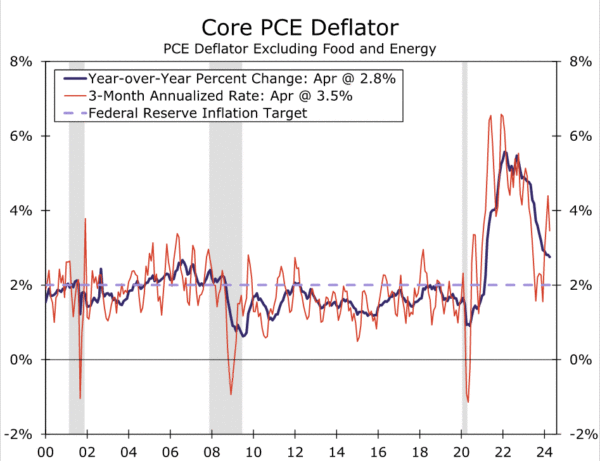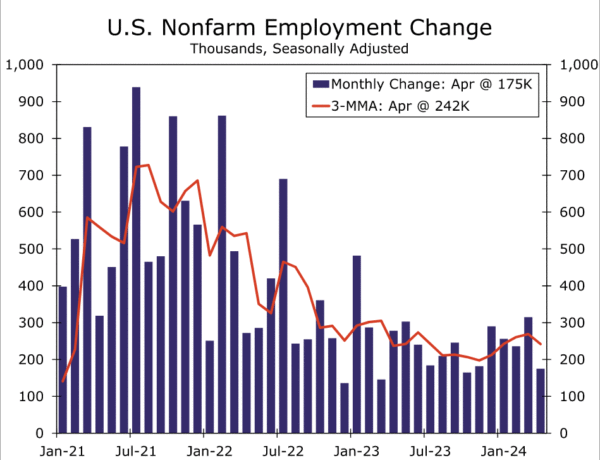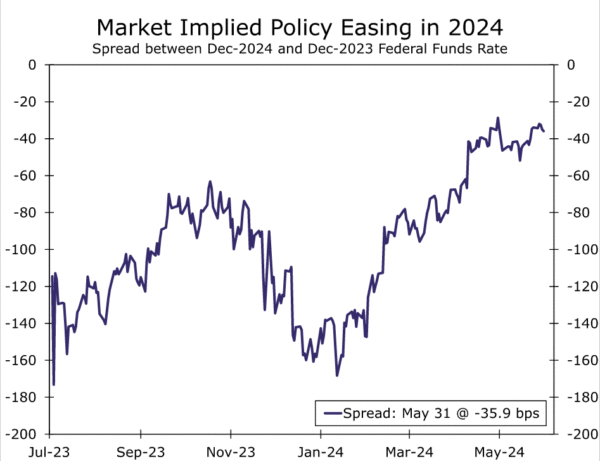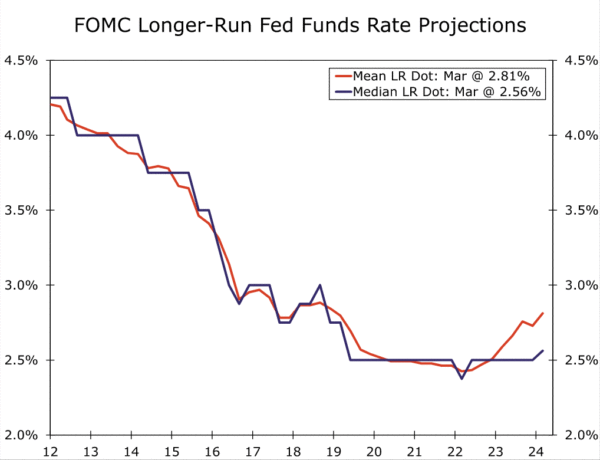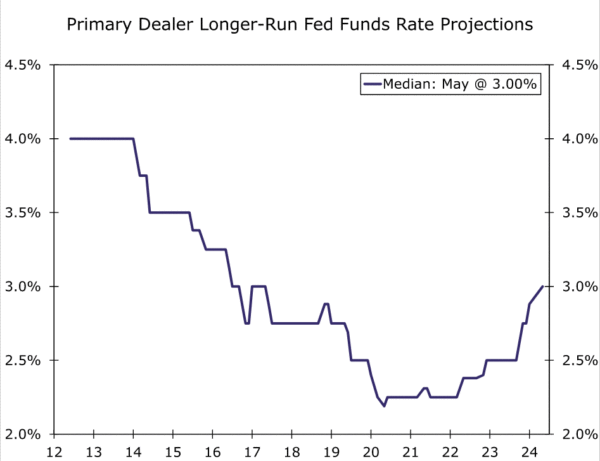Summary
- The FOMC remained on hold for the sixth consecutive policy meeting on May 1 as elevated inflation and strong job growth earlier this year led policymakers to conclude that policy easing at that time would not be appropriate.
- Data released since the last meeting indicate that the threat of price re-acceleration due to strong economic activity has diminished somewhat. However, we share the universal expectation that the FOMC will keep its target range for the federal funds rate unchanged at 5.25%-5.50% at the conclusion of its policy meeting on June 12.
- We expect to see a nod in the post-meeting statement to the recent mix of activity and price data suggesting a lower risk of price re-acceleration, but we think the Committee will continue to characterize inflation as “elevated.”
- The FOMC will publish its quarterly update to the Summary of Economic Projections (SEP). The last dot plot, which was released in March, showed the median Committee member anticipated 75 bps of easing by year-end 2024. We look for the median projection in the updated dot plot to signal 50 bps of easing by the end of the year. However, we would not be surprised if the median dot shifted up to only 25 bps of anticipated rate cuts in 2024. The May employment report to be released on June 7 may be the deciding factor.
- We will also be keeping a close eye on the Committee’s “longer-run” fed funds rate projections. The median longer-run dot was essentially unchanged at 2.5% between June 2019 and December 2023. The median ticked up ever so slightly to 2.56% in the March SEP, and our best guess is that the median longer-run dot is headed modestly higher in the June SEP, probably to a value between 2.625% and 2.75%.
- We do not look for any major changes to the macroeconomic forecasts in the SEP. The Committee’s projections for real GDP growth do not seem likely to change materially.The median forecast for the unemployment rate at year-end 2024 may increase by a tenth or two, and median projections of PCE and core PCE inflation rates for this year seem likely to increase by about 0.2 ppt each in our view.
Fewer Signs of Prices Re-Accelerating, but Holding Pattern to Remain
“A lack of further progress” on the inflation front since the start of the year led the Federal Open Market Committee to hold the fed funds target range at 5.25%-5.50% for a sixth straight meeting on May 1. Data in the three months proceeding the FOMC’s May meeting showed core PCE inflation strengthening to a 4.4% annualized clip, more than double the pace registered in the second half of 2023 that had previously suggested inflation was quickly returning to the Fed’s 2% target. Stronger job growth over the same period alongside a solid pace of activity made inflation’s early-year pickup even more unsettling, as sturdy demand stoked concerns that disinflation may have ended prematurely and price growth was at risk of picking up again.
Since the Fed’s last meeting, however, the threat of prices re-accelerating and economic growth remaining defiant has weakened somewhat. Inflation as measured by the core PCE deflator eased in April, with the three-month annualized rate slowing to 3.5% (Figure 1). At the same time, job market rebalancing looks to have resumed. Payroll growth downshifted to 175K in April from an average monthly increase of 269K in Q1, the unemployment rate has risen to match a two-year high of 3.9%, while job openings/postings show demand for new workers continues to decline (Figure 2). There are fewer signs of current activity shifting into a higher gear as well. Both the ISM manufacturing and ISM services indices registered contractionary readings in April, and real consumer spending edged down over the month.
While more moderate signs of spending and hiring suggest inflation pressures continue to ease, Fed officials have made clear the need to see additional realized progress before reducing the fed funds target range. April’s data marked a step in the right direction. However, it still leaves inflation running above target for more than three years and follows a stretch of data that reminded Fed officials of the difficulty in returning inflation to 2% for the long haul. Given this backdrop, we expect the FOMC to leave the fed funds target rate unchanged at the conclusion of its June 11-12 meeting and for the statement to omit any hints of a forthcoming rate cut. Market participants expect a similar outcome, with futures pricing in essentially no chance of a rate change at the June meeting and the next rate move as a cut in Q4.
With the FOMC remaining in a holding pattern, there are likely to be only a few changes to the post-meeting statement. The language around balance sheet run-off will need to be updated to reflect the lower run-off caps for Treasury securities announced at the prior meeting that are now in place. More meaningfully, we expect to see a nod to the recent mix of activity and price data suggesting a lower risk of price re-acceleration ahead. The description of recent economic activity, including hiring, likely will be softened somewhat. The Committee will likely continue to make clear it believes inflation remains too high by continuing to characterize it as “elevated.” However, the statement could acknowledge April’s better data by noting that, instead of “a lack of further progress” in recent months, there has been “a lack of consistent progress toward the Committee’s 2 percent inflation objective.”
The statement’s guidance around the path of policy likely will remain unchanged. A chorus of Fed speakers in recent weeks have indicated that the need to gain “greater confidence that inflation is moving sustainably toward 2 percent” remains. For clues about the path for the fed funds rate further into this year and 2025, we will look to the update to the Summary of Economic Projections (SEP).
SEP Update: One Cut or Two in 2024?
The SEP, which is released four times per year, was last updated in March. At that time, the median Committee member anticipated 75 bps of easing by year-end (Figure 3). However, the 2024 dots had a decisively upward skew; nine Committee members projected two or fewer rate cuts this year, while just one envisioned more than 75 bps of easing.
Given that inflation has proved a bit stickier than was anticipated in March, it seems like a foregone conclusion that the median 2024 dot is headed higher. The question is, how much higher? We would be very surprised if the median dot moved all the way to 5.375% (i.e. no rate cuts in 2024). A move to 5.125% or 4.875% seems much more likely in our view. As of this writing, we lean slightly toward a median 2024 dot of 4.875%, which would be consistent with two 25 bps rate cuts by year-end. That said, we would not be surprised if the median 2024 projection calls for just one rate cut. We think it will be a close call, with the dovish leaning members still looking for two cuts while the more hawkish leaning members projecting one or zero rate reductions this year. The May employment report to be released on June 7 may be the deciding factor. Financial markets also seem torn between one and two cuts this year, with ~35 bps of easing by year-end priced into fed funds futures (Figure 4). If our base case is realized and the 2024 median dot rises by 25 bps, we would expect the 2025 and 2026 median dots also to rise by 25 bps each, bringing them up to 4.125% and 3.375%, respectively.
We will also be keeping a close eye on the “longer-run” (LR) fed funds rate projections. The longer-run projections represent each participant’s assessment of the fed funds rate that would best satisfy maximum employment and price stability over the longer run. In other words, the LR fed funds rate projections are the participants’ views on the neutral policy rate. The median longer-run dot steadily fell for most of the 2010s, eventually settling at 2.5% in 2019. The median LR dot essentially did not move between June 2019 and December 2023. But starting in 2023, the mean LR dot began to climb as a handful of outliers started raising their longer-run projections, and the median ticked ever so slightly higher in the March SEP (Figure 5).
It would not take much for the median LR dot to rise again in the June SEP. Eight participants submitted an LR dot of 2.50% in the March SEP. If just one of those submissions moves up to 2.75%, the median would increase from 2.56% to 2.69%. Two participants flipping from 2.50% to 2.75% would be enough to make the new median 2.75%, all else equal. Furthermore, there seems to be increasing debate about the neutral rate and the degree to which monetary policy is restrictive. The topic came up in the minutes from the May FOMC meeting, and Governor Waller dedicated a recent speech to the topic of r-star. The New York Fed’s Survey of Primary Dealers reveals a growing consensus among private sector forecasters that the neutral policy rate has moved higher (Figure 6). Thus, our best guess is that the median LR dot is headed higher in the June SEP to reflect this new reality, probably to a value between 2.625% and 2.75%.
Elsewhere in the SEP, we do not expect any major changes. The Committee’s projections for real GDP growth do not seem likely to change much. The median projection in the March SEP for 2024 real GDP growth was 2.1%. Our most recent forecast is not much different and looks for 1.8% real GDP growth in 2024 on a Q4/Q4 basis. We do not see any compelling reason the 2025 and 2026 median growth numbers would move much from their current trend-like 2% projections.
The median projection in the March SEP for the unemployment rate in Q4-2024 was 4.0%, and we think this may rise by 0.1-0.2ppt. The current unemployment rate is 3.9%, although this may change in the May employment report to be released on June 7. We would interpret any small rise in the Committee’s median projection for the unemployment rate as a reflection of the gradual uptick in the jobless rate since the end of 2023. We do not expect any changes to the median projections for the unemployment rate in 2025 or 2026.
We expect the median 2024 PCE and core PCE inflation projections to rise by about 0.2 ppt each. In March, the median participant expected headline PCE inflation of 2.4% and core PCE inflation of 2.6% in 2024. Our latest forecast is for 2.6% on headline and 2.8% on core, and we expect the median Committee projection to be close to our most recent forecast. The 2025 and 2026 inflation projections may rise by a tenth to reflect the stickier dynamics seen through the first half of this year, but upward revisions by a larger amount do not seem likely to us.




